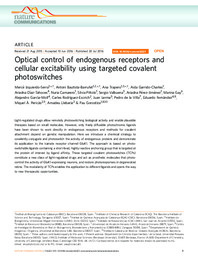Por favor, use este identificador para citar o enlazar este ítem:
https://hdl.handle.net/11000/35415
Optical control of endogenous receptors and cellular excitability using targeted covalent photoswitches
Título :
Optical control of endogenous receptors and cellular excitability using targeted covalent photoswitches |
Autor :
Izquierdo-Serra, Mercè 
Bautista-Barrufet, Antoni
Trapero, Ana
Garrido Charles, Aida 
Díaz-Tahoces, Ariadna 
Camarero, Nuria
Pittolo, Silvia
Valbuena, Sergio
Pérez-Gimenez, Ariadna
Gay, Marina
García-Moll, Alejandro
Rodrıíguez-Escrich, Carles
Lerma, Juan
de la Villa, Pedro
Fernández, Eduardo |
Editor :
Nature |
Departamento:
Departamentos de la UMH::Fisiología |
Fecha de publicación:
2016-07 |
URI :
https://hdl.handle.net/11000/35415 |
Resumen :
ight-regulated drugs allow remotely photoswitching biological activity and enable plausible therapies based on small molecules. However, only freely diffusible photochromic ligands have been shown to work directly in endogenous receptors and methods for covalent attachment depend on genetic manipulation. Here we introduce a chemical strategy to covalently conjugate and photoswitch the activity of endogenous proteins and demonstrate its application to the kainate receptor channel GluK1. The approach is based on photoswitchable ligands containing a short-lived, highly reactive anchoring group that is targeted at the protein of interest by ligand affinity. These targeted covalent photoswitches (TCPs) constitute a new class of light-regulated drugs and act as prosthetic molecules that photocontrol the activity of GluK1-expressing neurons, and restore photoresponses in degenerated retina. The modularity of TCPs enables the application to different ligands and opens the way to new therapeutic opportunities.
|
Tipo de documento :
info:eu-repo/semantics/article |
Derechos de acceso:
info:eu-repo/semantics/openAccess
Attribution-NonCommercial-NoDerivatives 4.0 Internacional |
DOI :
10.1038/ncomms12221 |
Publicado en:
Nat Commun . 2016 Jul 20:7:12221 |
Aparece en las colecciones:
Artículos Fisiología
|
 La licencia se describe como: Atribución-NonComercial-NoDerivada 4.0 Internacional.
La licencia se describe como: Atribución-NonComercial-NoDerivada 4.0 Internacional.
 La licencia se describe como: Atribución-NonComercial-NoDerivada 4.0 Internacional.
La licencia se describe como: Atribución-NonComercial-NoDerivada 4.0 Internacional.
.png)
